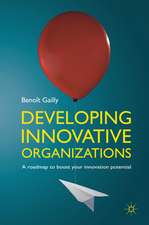Implementing Strategic Change – Managing Processes and Interfaces to Develop a Highly Productive Organization
Autor Daniel Samson, Tom Bevingtonen Limba Engleză Paperback – 2 apr 2012
One of the key success factors for any organization is effective strategic change to ensure adaptability and increase productivity. Despite their importance, most change management projects fail – Samson and Bevington's research points to an average process failure level of at least 30% – and the problem is often the conflict between boardroom strategic initiatives and the procedural design.
Their analysis shows that most conflict occurs during seemingly small activities that help drive a process forward and can make up to 80% of many employees' workload – tasks like chasing, following up or seeking permission to proceed. Their experience with over 400 companies in a range of industries proves that business strategy and change implementation rely on deep and close process knowledge. In this book, they offer proven productivity improvement tools to analyze process activities and rigorous and detailed methods to reengineer processes and make change successful.
Preț: 366.17 lei
Nou
Puncte Express: 549
Preț estimativ în valută:
70.07€ • 76.09$ • 58.86£
70.07€ • 76.09$ • 58.86£
Carte tipărită la comandă
Livrare economică 22 aprilie-06 mai
Preluare comenzi: 021 569.72.76
Specificații
ISBN-13: 9780749465544
ISBN-10: 0749465549
Pagini: 248
Dimensiuni: 157 x 234 x 14 mm
Greutate: 0.38 kg
Editura: Kogan Page
ISBN-10: 0749465549
Pagini: 248
Dimensiuni: 157 x 234 x 14 mm
Greutate: 0.38 kg
Editura: Kogan Page
Cuprins
Foreword
Preface
Introduction
Organizational impact of toxic interfaces
The failure of strategic change
Interfaces are not the problem
Best practice using interface mapping
Too good to be true?
How much will this cost?
Does it work in practice?
01 Business strategy - rigorous formulation, routine underachievement
Objectives
Introduction
Only half a solution?
Two parts to the strategy - an uncomfortable truth
A need for a change in thinking
Increasing criticality of managing interfaces
Undocumented interfacing activities make up over 50 per cent of routine work steps
Interfacing activities' invisibility
Interfacing activities and strategic impact
Century-old practices abound
Summary
02 Strategic outcomes from best-practice management principles
Objectives
Introduction
A complete set of management principles
Understanding the management principles
Link between best-practice principles and interfacing activity
Using principles to achieve staff and management alignment
Summary
Appendix
03 Making the change needs obvious - the critical role of interfacing activities
Objectives
How it all started
Exploring interfacing activity
Mapping reality - the paradox
Searching for an approach to mapping interfacing activity
Documenting what really happens
Importance of missing interfacing activities
Confidence from interfacing activity data
The management challenge quantified
Summary
Appendix
04 Interfacing activities, business strategy and business process innovation
Objectives
The need for strategic activity categorization
Relating value-added activities to a strategic framework
Support and core activities
Relationship between core activity and noise
Interfacing activity noise drives process innovation
Noise as an indicator of potential
Summary
05 Interface activity noise - the foundation of strategic change capability
Objective
The data
A huge opportunity
Outcome achievement
Situational dependency
Discretionary activity
Summary
06 Increasing performance
Objective
Continuous improvement or strategic process alignment?
Value revealed by interface mapping
Difficulties in addressing noise
Analysing noise drivers to achieve strategic outcomes
Summary
07 Organizational 'genomics' - strategic process analysis focused on implementation
Objectives
Introduction
Need for a new 'genomic' framework - summary
The real issue with interface mapping
Organizational 'genomics'
How interface mapping meets the need
Analysing and using interface mapped data
Strategically defi ning business process change
Summary
08 Principles by which leading organizations drive change
Objectives
Introduction
Need for the deployment culture management principles
Exploring the deployment culture management principles
Contrasting approaches
Multi-organization process management
Summary
09 Using interface mapping to deliver performance
Objectives
Introduction
Relationship between interfacing activities and the management principles
Installing the principles and aligning business processes
Conclusions
10 Staying on top: maintaining business outcomes
Objectives
Introduction
Common approaches to business process change do not last
Continuous, strategic business process alignment
Interfacing activities continually change
Up-to-date interface maps
Essential features of an ongoing interface mapping programme
Month 1 deliverables
Determining change priorities strategically
Delivery of the required changes
Locking in the changes - BCIs
The last step
Conclusions
11 Definitions and an example of an interfacing mapping tool
Definitions
Interface mapping tool
References and Literature Researched
Index
Recenzii
"Not just another book on Six Sigma or business process re-engineering (BPR), this work looks at a usually neglected piece of the workday - the need to streamline 'interfacing activity.'" --Book News, Inc.
"[P]rovides a useful integrating framework for combining many of the important factors required for successfully implementing strategic change." --Tor Guimaraes, Professor, Information Technology Services, Tennessee Tech University
"[P]rovides a useful integrating framework for combining many of the important factors required for successfully implementing strategic change." --Tor Guimaraes, Professor, Information Technology Services, Tennessee Tech University
Notă biografică
Danny Samson is Professor of Management at the University of Melbourne (Australia), and he is also Director of the Foundation for Sustainable Economic Development there. He spent ten years working on corporate strategy with the CEO and top team of an international bank with branches in the UK, USA, New Zealand and Australia. He regularly provides industry and executive seminars.
Tom Bevington is a partner in Bevington Group and its sister company Bevington Process Management Tools. He was CEO of an international computer services organization with operations in 49 countries. His clients have included GE Capital, ANZ, Commonwealth Financial Services, AMP, AXA and Tower.
Descriere
Samson and Bevington's experience with over 400 companies in a range of industries proves that change implementation relies on deep process knowledge. They offer proven productivity improvement tools to analyze process activities to make change successful.


















